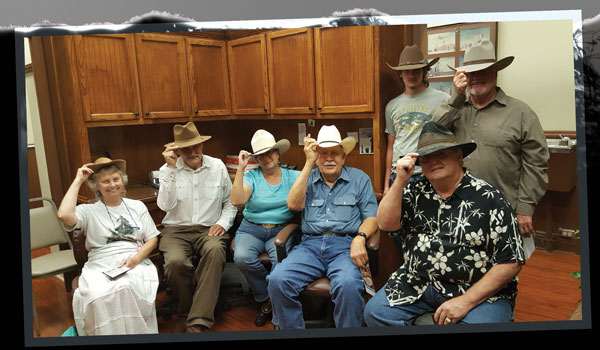
The word cowboy doesn’t conjure images of a great literary mind raptly pondering the meaning of life, hunkered over a polished table in a book-lined library, but cowboy poetry has more in common with other literary genres than one might think. Like the plays of William Shakespeare, cowboy poetry is to be heard, not read, and loses more than a little something on paper. It’s the art of oral tradition. It’s passing knowledge, cultural understanding, history and some tall tales from generation to generation sans the necessity of paper and ink, commodities in short supply on the cattle drives where the art was born.
Today’s poets, whose day-to-day grammar and pronunciation may be impeccable, adopt a persona-transforming twang and vocabulary as they perform. Listeners quickly forget the poet is a local business owner or professional, as the rhymester slips into character to deliver lines such as, “That’s Mr. Chambers’ creek you’re acrossin’. Keep them critters amovin’, you don’t want him to come abossin’.”1 Rhymester is the ideal term because one hallmark of cowboy poetry is that it rhymes, since rhyme and rhythm make memorization easier.

Contrary to what Western film genre sometimes portrays, cowboys of old, just as those today, were not unschooled ruffians. Many of those who first recited cowboy poetry probably had read, or at least heard, the verse of literary greats such as Tennyson, Browning and Longfellow, and fashioned their poems accordingly.
Cowboy poetry began around campfires where drovers, cooks and trail bosses gathered each night during the cattle drives of the late 19th century. The heyday of cattle drives lasted only from 1866 until the mid-1880s when the spread of rail transportation and the advent of refrigeration made them mostly unnecessary. Yet the image of the leather-faced cowboys, who rode the dusty trails atop their faithful horses, seems eternally branded into the psyche of Texans and non-Texans alike. Much of our fascination with the cowboy life stems from stories that originated in poems recited about the courageous, or sometimes dastardly, men who made their livings pushing herds of cows along unmarked dirt paths to markets north of the Red River.
Cowboy poetry is not just about history. Today, there is as much recited about current “cowboying” as old. The medium allows those whose lives, livelihoods and lifestyles are still connected inextricably to land and livestock to metaphorically gather around the campfire in camaraderie, as well as gives those who may have never mounted a horse a tiny taste of chuck wagon life.
Cowboy poets choose their words with the same exactitude as a painter chooses colors to elicit the desired response from listeners, therefore, the effective use of cowboy lingo is a must in a good cowboy poem. For those without firsthand experience on the range, constructing a poem can involve hours, even days, of research, poring over history books or anecdotal chronicles.

Today’s cowboy poets don’t gather around campfires to recite. Most gatherings occur in arenas or community buildings, where attendees often number in the thousands. In Texas, the largest cowboy poet gathering happens every winter in Alpine on the campus of Sul Ross State University. This year, that gathering will meet February 18-19. Other gatherings around the state include Fort Worth, La Grange and Fredericksburg, and there are scores throughout the Western states.
Editor’s Note: To learn more about cowboy poetry visit
https://lonestarcowboypoetry.com.
Sources:
1. “Thaddeus and Nathan” written and recited by David G. Smith of Waxahachie, TX, for the Oct. 15, 2016, commemoration of the Shawnee Cattle Trail historical marker dedicated to the drovers and cattle who passed through Ellis County, TX.
2. On the Trail of Cowboy Poetry, David Stanley, Westminster College, New Wilmington, PA; retrieved at https://static1.squarespace.com/static/5742241922482e19cfdae448/t/581cf408d2b85747b9cfff91/1478292536142/DaveStanley-2004-OnTheTrail.pdf
3. texasalmanac.com/topics/agriculture/cattle-drives-started-earnest-after-civil-war
Written by Sally Fuller

You must be logged in to post a comment.